THE ALTHORPE ISLAND EXPERIENCE
Rohdey and Dizz from All The Gear But No Idea, The South Australian Fishing Podcast, explain why they can’t get enough of this remote offshore island.
Althorpe Island sits about 8km south of Cape Spencer, on the southern end of the Yorke Peninsula. It is approximately 1.6km from north to south and 1.2km from east to west, with a total area of 91 hectares. It has a large plateau that makes up much of the island at 91m above sea level. A lighthouse sits in the middle of the island and has been in operation since 1879. There are several buildings around this, and there is also a jetty in the ‘bay’ on the island’s north-east shore. The rest of the shoreline is predominately rocky, with a steep incline towards the largely flat interior, and there are several rocky outcrops to the west of the main island. The coastline is rugged and picturesque and cops some pretty significant weather and swell for much of the year.
The Island is maintained by the ‘Friends of Althorpe Island Conservation Park’ who are involved in monitoring wildlife, maintaining the heritage listed cottage and surrounding buildings and removal of invasive weeds.
Most boats looking to fish the waters surrounding the islands launch from Marion Bay, a coastal town situated about three and a half hours from Adelaide, near the entrance to the Innes National Park. The town’s boat ramp is currently being rebuilt, with two lanes (including one wider for larger boats), a fixed jetty and a new carpark. The three million dollar project will make the ramp much easier for anglers to launch, particularly for larger boats which would struggle to launch from the sand at the bottom of the old ramp at certain times of the year.
From Marion Bay boats make the trip of approximately 20 kilometres to the south-west, travelling along the coast initially, before heading between Haystack and Seal Islands on the way out to ‘Althorpes’ as it is affectionately known. Alternatively, it is a similar distance by boat from Pondalowie Bay to the Island, although this is a true beach launch and another 20 minutes further away, and the boat journey is through less protected waters.
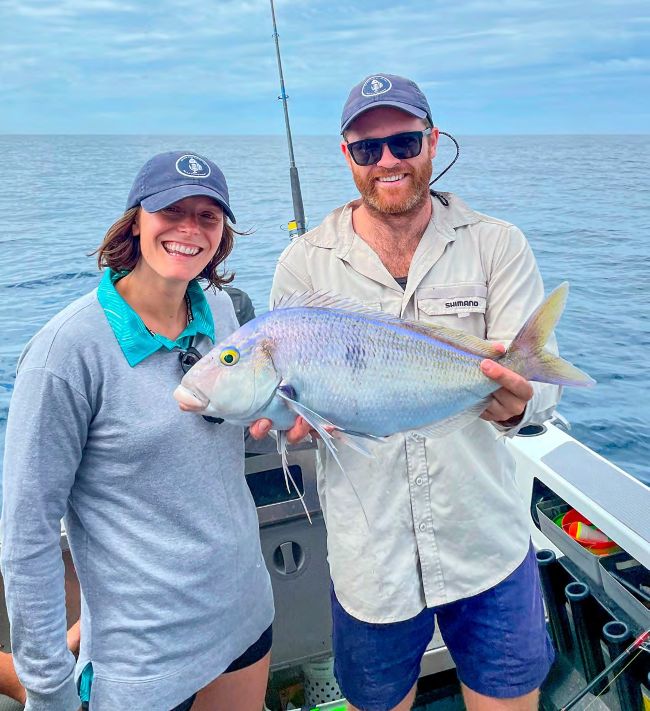
Blue morwong or queen snapper? Fun to catch and wonderful on the table
The beauty of Althorpes is the vast array of species that can be targeted in a day’s fishing. It truly is a place where you can pack all of your gear and work your way through different styles of fishing, depending on the conditions and success you may have. Trolling for tuna, jigging for kingfish and samson fish, or bottom bouncing for nannygai, plus the bread and butter species in the shallower waters of the bay and diving for crayfish and abalone can all be ticked off in a close proximity.
A typical day out for us would start with an early launch, having generally stayed somewhere locally to give us a full day on the water. Once we have made it off the coast and are steaming between the smaller Haystack and Seal Islands, our eyes are fixed to the horizon, looking for bird life or any signs of schools of southern bluefin tuna that frequent these waters during the warmer summer months, normally from about December through until March or April. Some days they can be easy to find, with jumping fish, diving birds and a flurry of activity a sure sign the fish are about.
On one memorable trip out in this area we only saw a faint ripple of movement on a glassy day and ended up catching and releasing as many tuna as we wanted, while heading back in past Seal Island. All of the normal techniques will have effect, with trolling skirts or hard-body lures or skirts the most popular, while casting stick baits can also provide good success if you are able to get closer to the school. Tuna can often be found between the three Islands (Althorpe, Seal and Haystack), while it is also worth blind trolling a wide lap around Althorpe Island or venturing further west towards South West Rock and Emmes Reef in search of fish.
The next main targets we have around this area are kingfish and Samson Fish, which can be caught in a variety of ways. Getting in close (but not too close!) to one of the above islands or reefs and casting stick baits into the rough water can be successful, although it can be hard to know when or where the fish are using this method. Dropping knife jigs around any of the lumps found in this area can be successful, particularly if fish can be seen sitting just up off the bottom on the sonar. Keeping an eye on the screen while trolling for tuna and looking for lumps that seem worth a jig is well worthwhile, particularly if your sounder is good enough to pick up which lumps may be holding fish while at trolling speed.
Generally, jigs in the 150-250g range are best, depending on the drift speed and current, with all of the popular jigs doing the job, particularly those with bright contrasting colours. Live baits can also be used for these two species, with squid a prime option that can be collected along the coast on the way out to the island.
If filling the esky is a priority, nannygai are a great option to target around Althorpe Island. They can be abundant on some of these deeper lumps scattered around this area, and are one of the best eating fish available in SA waters. We recently put a post up on social media asking whether people preferred to eat King George Whiting or nannygai, and were amazed at the overwhelming majority of our followers preferring the nannygai, or Bight redfish as they are also known. They are less commonly seen in restaurants or shops, but have a beautiful white, flaky flesh and a mild flavour, slightly sweeter than whiting.
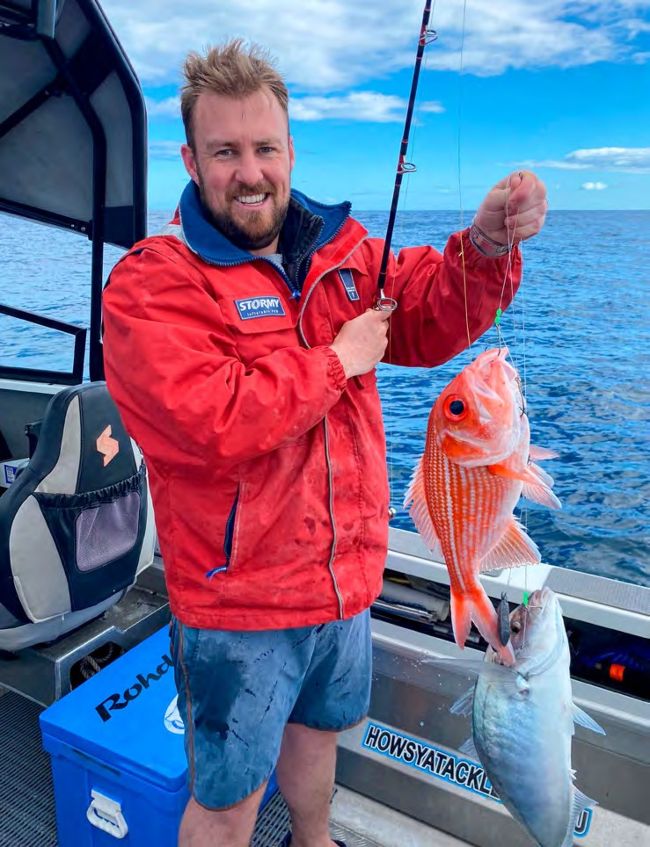
A trevally/nanny double – doesn’t get much better
Nannygai are targeted in a similar way to snapper, although they tend to be more abundant in deeper water. A standard paternoster rig, with about 8/0 size hooks and 50lb mono will do the job, with half pilchards an effective bait, or alternatively squid heads or strip baits if there are less desirable species picking at softer pilchard baits.
While nannygai can certainly be caught on larger knife jigs when targeting bigger fish as above, smaller ‘slow pitch’ jigs can often be more effective and can often outfish bait. These jigs are not as long, but are quite wide and are designed to be fished with a slower motion, lifting them up slowly and allowing them to slowly fall through the water column, as opposed to other jigs that are retrieved as fast as you can. Jigs in the 80-150g size are normally about right for these waters, but again this can be dependent on the conditions, while pink, red and silver colours have worked well for us. Most fish are caught near the bottom, so keeping your jig within a couple of metres of the reef is best, with lots of fish actually hooked as the jig is slowly ‘fluttering’ towards the bottom. Another option to target nannygai effectively can be the hugely popular Shimano Lucanus jig, which has made a recent comeback to the shelves due to high demand. These bright jigs look a bit like an octopus with a bright weighted head and lots of soft plastic strands and two strong assist hooks trailing off the bottom. The other lure that can be effective for this type of fishing is the Vexed Bottom Meat, a hybrid lure with a coloured jig head and UV skirt which sits over the top of three snelled hooks, meaning a strip of squid or other bait can be added. This gives the additional benefit that the jig itself can be enough to entice a bite, even if the bait has been picked off.
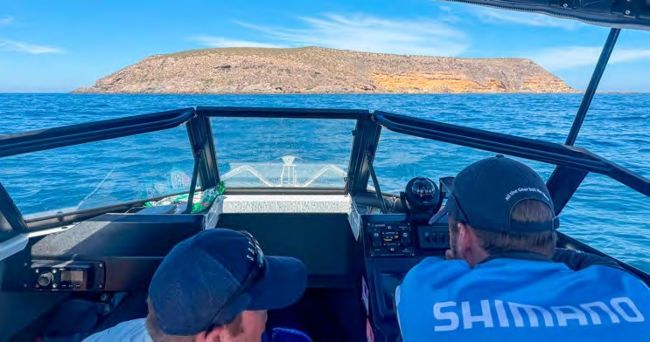
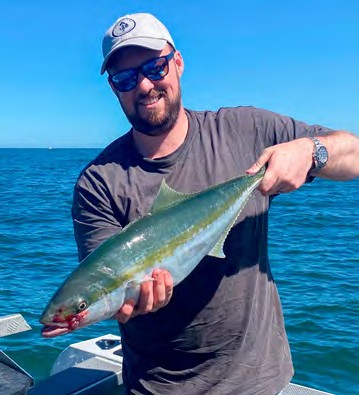
Rat kings are common
Nannygai live in tight schools, normally staying close to structure, with lumps of rock or reef the best spot to target. These lumps can again be picked off on your sounder while trolling around for tuna, or a bit of scanning around on the Navionics app can find areas worth exploring further. It is good to have lots of these lumps saved in your GPS, as the fish tend to move around quite a bit, giving you the option of keeping on moving until you find them. We normally drift over them to cover more ground, as the school of fish is often found to the side of the main structure. A lot of our marks are within a kilometre or two of the south and west borders of the island, so this is a good place to start looking. As a welcome bycatch we have often caught a couple of blue morwong in these same areas, another attractive looking fish. They grow bigger than nannygai and have a similar tasty flesh.
Around lunchtime we often head into the more protected waters to the north-east of the island and fire up the propane cooker for some sausages in bread while drifting for bread and butter species. Whiting and flathead can both be caught within the picturesque bay, and we again tend to drift to cover more ground, using a standard paternoster rig and fishing mostly within 8-10m of water. A berley pot seems to help, by either bringing the fish in towards your drift, or maybe by stirring up the water and firing up some flathead off the bottom. These flathead are predominantly small, often just over the legal limit of 30cm, but are another great eating fish to add to your target list. On a hot summer’s day anchoring up and having a swim over the sandy bottom alongside the small jetty can be very refreshing!
If you are someone who prefers to be in the water rather than on top of it, Althorpe Island certainly has something to keep you happy too! There are plenty of rocky ledges all around the island that are home to some good size crayfish if you have access to a hookah or are a diver. Abalone can also be collected, while a friendly seal or dolphin may pay you a visit. While diving this far off the mainland is not for the faint hearted, this can be a great way to really finish off your fisherman’s basket.
While we personally haven’t joined the growing trend of anglers who have successfully caught barrel-sized southern bluefin tuna in these waters (or anywhere for that matter!), it is something we would love to tick off in the coming seasons! These tuna that can grow to well over 100kg have been targeted in the south east of the state, largely out of Port MacDonnell for over 20 years. In the past few years reports have been coming out of Port Lincoln and Marion Bay that these large fish are being landed there too. Initially this was kept pretty quiet, with locals keen to keep the secret under wraps, but over time there has been increasing numbers of boats having success on these trophy fish.
Winter is the prime time to target them, with June and July the ideal months if previous years are anything to go by. As opposed to the summer run of smaller fish that move in schools, these larger models are more solitary, however do seem to come together to hunt bait in hotspots such as the waters around Althorpe Island. They are targeted in a similar way to school fish, mostly using large skirts in the 8-10 inch range, with heavier overhead gear preferable. The fish can occasionally be found surprisingly close to the coast from Rhino Head to Cape Spencer, but are more commonly found out around the islands, including South West Rock and Althorpe Island itself. As with all tuna, they do move around a lot from day to day, let alone year to year, and recent reports are the best guide to where and when they may pop up!
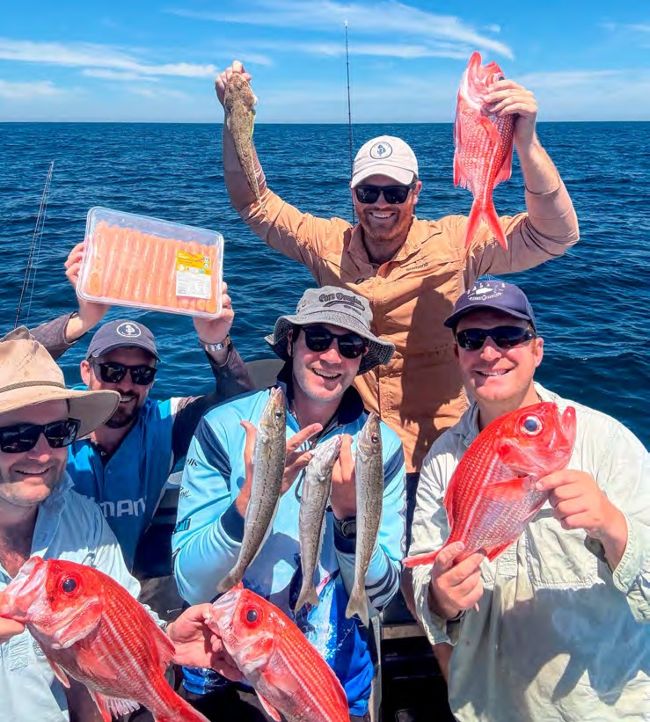
Quality seafood all round!
As well as fish, the Althorpe Island area is home to an abundance of other animal life to match the stunning scenery. Eastern osprey and white bellied sea eagles call the islands home, while plenty of mutton birds and gannets can be used to help you find the schools of tuna. In years gone by a large colony of little penguins (previously called fairy penguins) called Althorpe Island home. As with many of these colonies around the state, their numbers have declined, but are hopefully on the increase again with improved protection.
During winter plenty of whales pass through the area, with humpbacks being the most common. Anglers can regularly see these giant mammals as they feed on similar bait to the barrel-sized tuna. Dolphins are plentiful all through this area all year round. Althorpes and the surrounding islands are home to the endangered Australian sea lion, as well as the more common New Zealand fur seal. One more rare, but very significant sighting in the area was in March 2021 when local charter boat Reef Encounters spotted and photographed a pod of orcas within close proximity to Althorpe Island. This super rare sighting is further evidence of the diversity of the area and the untamed and mysterious waters that surround it.
Without doubt, a day out fishing around Althorpe Island is one of our favourite experiences in SA and something we can’t wait to continue doing into the future. The diversity of species, the stunning scenery and the feeling of being a long way away, while still being close enough to do as a day trip are all what keeps us coming back!